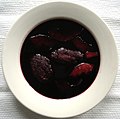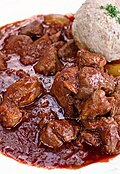List of German soups
This is a list of German soups. German cuisine has evolved as a national cuisine through centuries of social and political change with variations from region to region. In Germany, soups are a popular and significant food, and many Germans eat soup at least once a week.[1] In German cuisine, it may be served as a first course or as a main course.[1] The use of a roux to thicken soups is common in German cuisine.[2] The use of legumes and lentils is significant and used in several German soups, such as split pea soup.[2] Common soups in German restaurants include oxtail, beef or chicken broth with noodles, dumplings, or rice, goulash, split pea, cream of asparagus, turtle soup (Echte Schildkrötensuppe) and cream of lobster.[1]
In the 1880s, Germans had an appreciation for soups prepared with beer as a primary ingredient, which was prepared with beer with a lesser alcohol content compared to standard beers.[3] One recipe utilized beer, water, sugar, raisins, spices and grated, stale bread.[3]
This list includes soups that originated in Germany as well as those that are common in the country.
German soups[]
| Name | Image | Type | Description |
|---|---|---|---|
| Asparagus Soup (Spargelsuppe) | Soup | A creamy soup made from asparagus. | |
| Beer soup[4] | 
|
Soup | In medieval Europe, it was served as a breakfast soup,[5] sometimes poured over bread. Pictured is beer cheese soup. |
| Brain soup [3] | Soup | ||
| Bread soup[3] | 
|
Soup | A simple soup, that mainly consists of stale bread and some variations exist in many countries, and it is often eaten during Lent. Bread soups are created as well with brown bread as with white bread. |
| Beansoup (Saarland Bohnesauf/Bippelches Bohnesupp) | 
|
Soup | Soup of beans, carrots, potatoes, onions and bacon |
| Borscht | 
|
Soup | A beetroot-based soup served with sour cream (schmand) and beef (originally from Ukraine) |
| Buttermilchsuppe | Soup | Buttermilk soup with flour dumplings | |
| Cheese soup[3] | 
|
Soup | All through the middle ages, soup prepared from cheese, eggs and pepper was commonly served in German monasteries.[3] Pictured is a cheese and potato soup. |
| Crawfish soup [3] | Soup | ||
| Eintopf | 
|
Soup | A simple vegetable soup; small meat balls are optional but common in it. |

|
Dessert | A dessert soup made from elderberry, served with semolina dumplings | |
| French onion soup[1] | 
|
Soup | A very common soup in German cuisine.[1] |
| Fruit soup[3] | 
|
Soup | Cherry soup (pictured) has been described as a seemingly popular soup in Germany.[3] |
| Goulash[1] | 
|
Soup or stew | Pictured is Bavarian Gulash mit Semmelknödel which is often made with a mix of beef and pork. Here it is served with a Semmelknödel, a bread dumpling. |
| Grumbeersupp un Quetschekuche | 
|
Main course | Potato soup and plum tart |
| (Hamburg Eel Soup) [6] | 
|
Soup | A sweet and sour soup of eel, meat broth, dried fruits, vegetables, and herbs. |
| Hochzeitssuppe (literally "wedding soup") | 
|
Soup | A spicy meat broth with bread dumplings, liver dumplings and finely sliced pancakes |
| Kartoffelsuppe | 
|
Soup or stew | A stew made with raw potatoes and other ingredients such as vegetables and sausages. |

|
Soup | A lightly bounded soup usually with acidified vinegar from tripe, regional spot or spots mentioned, which is common in variants in numerous countries. | |
| Lentil soup | 
|
Soup | Prepared throughout the year in Germany, in part because the dry lentils store well.[2] Pictured is yellow Lentil soup with melted butter and fried onions. |
| Milk soup [3] | Soup | Consumed with semolina by Germans in the 1880s.[3] | |
| Nudelsuppe [3] | 
|
Soup | Strong chicken stock and noodles[3] |
| Potato soup [2] | 
|
Soup | A common soup throughout Germany.[2] |
| Rumford's Soup | 
|
Soup | A simple soup prepared with barley or barley meal and dried peas as primary ingredients that was utilized in Munich and greater Bavaria to feed impoverished people.[7] |
| Schälklöße | Soup | Consists of filled pasta and various vegetables | |
| Schwarzsauer [8] | Soup | A type of pork blood soup with various spices cooked in vinegar-water.[8] A sort of black pudding made with vinegar. The dish originated in eastern Prussia.[8] | |
| Snail soup | Soup | Can be found in Baden cuisine |
In culture[]
The German tale of Suppenkasper in the children's book Der Struwwelpeter involves "a little boy who faded away because he refused to eat his soup".[1]
See also[]
References[]
| Wikimedia Commons has media related to Soups of Germany. |
- ^ a b c d e f g Sheraton, M. (2010). The German Cookbook: A Complete Guide to Mastering Authentic German Cooking. Random House Publishing Group. p. 79. ISBN 978-0-307-75457-8. Retrieved January 25, 2015.
- ^ a b c d e Heberle, M.O. (1996). German Cooking. HPBooks. p. 56. ISBN 978-1-55788-251-6. Retrieved January 25, 2015.
- ^ a b c d e f g h i j k l m Rumble, V.R. (2009). Soup Through the Ages: A Culinary History with Period Recipes. McFarland, Incorporated Publishers. pp. 77–78. ISBN 978-0-7864-5390-0. Retrieved January 25, 2015.
- ^ Smith, H. (2008). The Master Books of Soups. Cooking in America Series. Applewood Books. p. 176. ISBN 978-1-4290-1180-8. Retrieved January 25, 2015.
- ^ 1,001 Foods to Die For - Andrews McMeel Publishing, Madison Books - Google Books
- ^ Sheraton, M. (2010). The German Cookbook: A Complete Guide to Mastering Authentic German Cooking. Random House Publishing Group. p. 105. ISBN 978-0-307-75457-8. Retrieved January 25, 2015.
- ^ Kellogg, D.O.; Baynes, T.S.; Smith, W.R. (1903). The Encyclopædia Britannica: New American supplement. A-ZUY. The Encyclopædia Britannica: A Dictionary of Arts, Sciences, and General Literature. Original 9th Ed. in 25 Vols. Werner. p. 673. Retrieved January 24, 2015.
- ^ a b c Chaffey, D. (2010). Dirty German. Dirty Everyday Slang Series. Ulysses Press. p. 272. ISBN 978-1-56975-850-2. Retrieved January 25, 2015.
- German soups
- Soup-related lists
- German cuisine-related lists